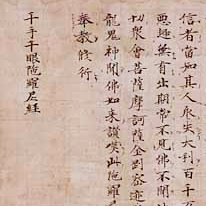Past Exhibitions
- Sutra Manuscripts of the Nara Period
- February 3, 2015 - March 1, 2015
Scriptures containing the sacred teachings of the Buddha are fixed, and cannot be edited or altered in any way. Scribes who copied such sutras in the Nara period (710–794) had to use standard script (kaisho), the most formal and austere form of handwriting. During the Tenpyō era (729–749) most sutra copying was done within the institutional structure of official scriptoriums. Young newly hired scribes were taught not only to write beautifully but also to maintain the same even form, tone, and spacing of characters throughout a scroll, from beginning to end. The great volume of sutra manuscripts produced during the Nara period exhibit both textually accurate and exquisite calligraphy.
This exhibition features seventeen outstanding works of Nara period Buddhist calligraphy, including four National Treasures, ten Important Cultural Properties, and one Important Art Object. Among them is Kongōjō darani kyō (National Treasure), which is Japan's oldest dated sutra manuscript.












